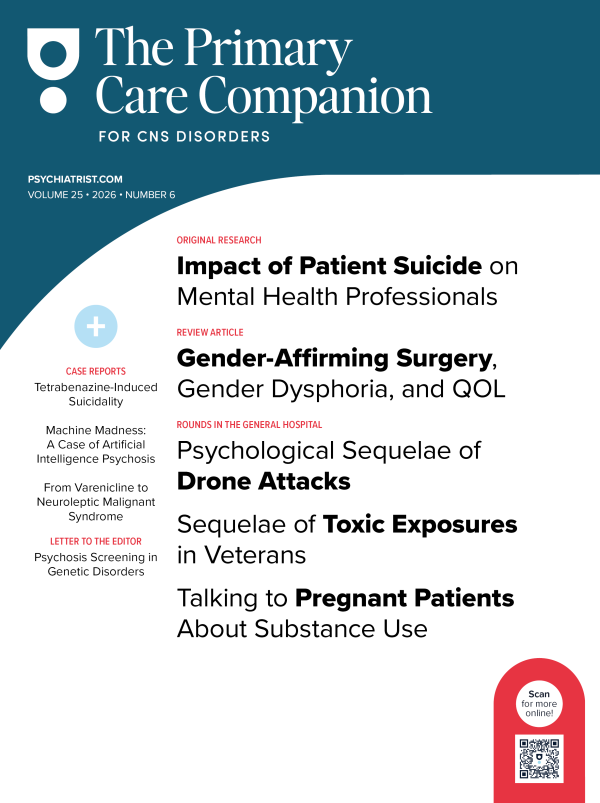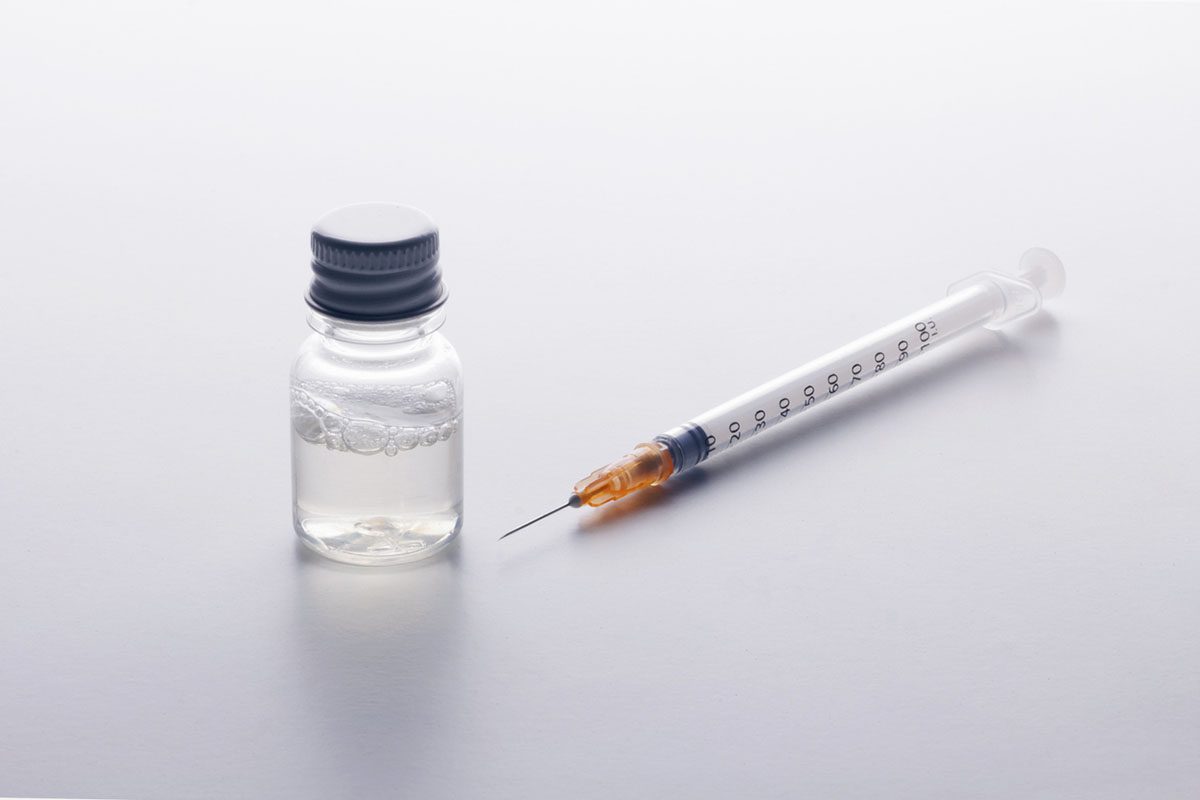Hyponatremia and Central Pontine Myelinolysis as a Result of Beer Potomania: A Case Report
To the Editor: Inpatients treated for alcohol dependence in both psychiatric and traditional hospital settings often demonstrate laboratory abnormalities with varying degrees of significance. Hyponatremia is a common electrolyte abnormality. Beer potomania is an uncommon cause of hyponatremia that is traditionally thought to occur from a combination of chronic ingestion of hypotonic alcohol solutions (ie, beer), combined with protein malnutrition, that cannot be accounted for by other causes.1-3 Hyponatremia in beer drinkers covers a wide spectrum of clinical significance from completely benign to potentially deadly.1-10 A case of severe hyponatremia due to beer potomania and the neurologic sequelae of central pontine myelinolysis (CPM) is reported along with a discussion of the clinical significance.
Case report. Mr A, a 33-year-old white man, was transferred in 2006 from the associated primary medical facility to the psychiatric addiction unit (dual diagnosis unit [DDU]) for treatment of alcohol dependence. He had been briefly admitted to the medical service for acute neurologic symptoms that consisted of dysarthria, dyspraxia, vertigo, and confusion. During his medical hospitalization, it was discovered that the patient had been hospitalized approximately 10 days previously due to unresponsiveness. Transfer records revealed that the patient was found unconscious by a friend and on emergent workup found to have a serum sodium level of 95 mmol/L. He was treated with intravenous fluids, after which his serum sodium level was corrected per standard of care guidelines of less than or equal to 10-12 mmol/L in the first 24 hours and less than or equal to 18 mmol/L in the first 48 hours. During this previous hospitalization, the patient responded well to the treatment and was discharged without symptoms on day 5.
Five days after his discharge, Mr A began to experience increasing neurologic symptoms, as previously described, ultimately leading to a traumatic fall down a hill while walking. The patient had at this time a past medical history of chronic hyponatremia, alcohol dependence including prior detoxification admissions, alcoholic hepatitis, and withdrawal seizures. His admission to our facility revealed a serum sodium level of 132 mmol/L, a serum potassium level of 3.2 mmol/L, a blood urea nitrogen level of 1 mmol/dL, and a serum creatinine level of 0.5 mmol/dL. Serum calcium, magnesium, and phosphate levels were within normal limits. Serum levels of the following components were as follows: albumin 2.9 mg/dL, aspartate aminotransferase 84 IU/L, alanine aminotransferase 86 IU/L, alkaline phosphatase 227 IU/L, and γ-glutamyltransferase 741 IU/L. Report from the previous hospitalization revealed a serum sodium level of 95 mmol/L, and after a negative computed tomography scan was obtained, magnetic resonance imaging (MRI) was ordered for suspicion of CPM secondary to the recent severe hyponatremia. The MRI confirmed an abnormal signal intensity in the central pons suggestive of CPM. His treatment in the hospital, in the DDU, and posthospitalization consisted of significant physical and occupational therapy. Regardless, residual movement and speech deficits were present several months after the second hospitalization.
This case displays several unique points in the interaction between the treatment of mental and medical illnesses, particularly substance use disorders (SUDs). It can be convenient to overlook an adequate medical evaluation in the treatment of SUDs with laboratory testing consisting of only a urine drug screen and blood alcohol level. Due to the ever-growing demand for medical services and various other factors, patients presenting for inpatient SUDs may be given minimal laboratory evaluation. Hyponatremia, especially in chronic hypotonic alcohol drinkers, is just one serious adverse condition that can occur in SUDs.11
First described in 1971,4 beer potomania has been reported in the literature approximately 23 times.1-10 It is a condition along the same spectrum as psychogenic polydipsia. The consumption of large amounts of hypotonic solution, whether water or beer, can lead to the dilution of serum sodium. Generally, hyponatremia is asymptomatic until serum levels fall below 125 mmol/L.11 Hyponatremia can result in nausea, vomiting, imbalance, seizures, and, in severe cases, coma and death.11 The patient described had a history of chronic hyponatremia, most likely due to his chronic alcohol consumption that began when he was a young teenager. He also had a history of withdrawal seizures and alcohol-induced cirrhosis requiring daily lactulose to maintain a serum ammonia level within normal limits. The exact duration or amount of alcohol that was consumed was unknown in this case, as the patient was discovered unresponsive by a friend. A blood alcohol level from his initial hospitalization was not available. However, transfer records from the emergency medical service personnel described a scene in which the patient’s residence was surrounded outside by “trash bags full of beer cans.” Additionally, the record described a scene in which they had to “wade” through empty beer cans to attend to the patient.
In this extreme case, the danger of developing CPM was very high regardless of the conservativeness of treatment. An extensive literature search revealed this to be the fifth case report of CPM as a direct result of beer potomania.4,8-10 As has been shown in other cases of severe hyponatremia, even the most conservative or slower-than-guideline corrections of sodium have resulted in CPM.12 This case would also lend support to the supposition that guidelines for severe hyponatremia should be much more conservative, as proposed by Sanghvi et al.10 The management recommendations propose, among others, a maximum serum increase of 10 mmol/L in the first 24 hours and a maximum of 18 mmol/L in the first 48 hours. The distinction emphasizes 10 mmol/L as the maximum rate of change and that correction of sodium resolves spontaneously without the use of hypertonic or isotonic fluids. Dilution was also recommended if serum sodium rose faster than the concrete goals.
This case highlights that a patient’s medical and psychiatric disease processes do not operate in a vacuum. Recognizing SUDs in the primary care setting and pursuing psychiatric consultation along with appropriate testing are paramount to the patient’s overall health. Conversely, those treating SUDs in the psychiatric setting must be attuned to the deceptive nature of underlying health issues that may result in a population with chronic health conditions masked by the resiliency of youth.
References
1. Hilden T, Svendsen TL. Electrolyte disturbances in beer drinkers: a specific “hypo-osmolality syndrome.” Lancet. 1975;2(7928):245-246. PubMed doi:10.1016/S0140-6736(75)90961-7
2. Joyce SM, Potter R. Beer potomania: an unusual cause of symptomatic hyponatremia. Ann Emerg Med. 1986;15(6):745-747. PubMed doi:10.1016/S0196-0644(86)80442-5
3. Fenves AZ, Thomas S, Knochel JP. Beer potomania: two cases and review of the literature. Clin Nephrol. 1996;45(1):61-64. PubMed
4. Demanet JC, Bonnyns M, Bleiberg H, et al. Coma due to water intoxication in beer drinkers. Lancet. 1971;2(7734):1115-1117. PubMed doi:10.1016/S0140-6736(71)91271-2
5. Gwinup G, Chelvam R, Jabola R, et al. Beer drinker’s hyponatremia: inappropriate concentration of the urine during ingestion of beer. Calif Med. 1972;116(3):78-81. PubMed
6. Swenson R, Rater DA. Electrolyte disturbances in beer drinkers. Lancet. 1976;1(7955):372-373. PubMed doi:10.1016/S0140-6736(76)90141-0
7. Evans JR, Main J, Mitchell PE, et al. Lactic acidosis and beer drinking. Scott Med J. 1985;30(4):237-238. PubMed
8. Kelly J, Wassif W, Mitchard J, et al. Severe hyponatraemia secondary to beer potomania complicated by central pontine myelinolysis. Int J Clin Pract. 1998;52(8):585-587. PubMed
9. Leens C, Mukendi R, Forêt F, et al. Central and extrapontine myelinolysis in a patient in spite of a careful correction of hyponatremia. Clin Nephrol. 2001;55(3):248-253. PubMed
10. Sanghvi SR, Kellerman PS, Nanovic L. Beer potomania: an unusual cause of hyponatremia at high risk of complications from rapid correction. Am J Kidney Dis. 2007;50(4):673-680. PubMed doi:10.1053/j.ajkd.2007.07.015
11. Adrogué HJ, Madias NE. Hyponatremia. N Engl J Med. 2000;342(21):1581-1589. PubMed doi:10.1056/NEJM200005253422107
12. Laureno R, Karp BI. Myelinolysis after correction of hyponatremia. Ann Intern Med. 1997;126(1):57-62. PubMed
Author affiliation: Department of Psychiatry, West Virginia University, Morgantown.
Potential conflicts of interest: None reported.
Funding/support: None reported.
Published online: August 26, 2010 (doi:10.4088/PCC.09l00936ecr).
Prim Care Companion J Clin Psychiatry 2010;12(4):e1- e2
© Copyright 2010 Physicians Postgraduate Press, Inc.





